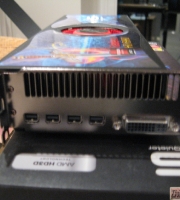

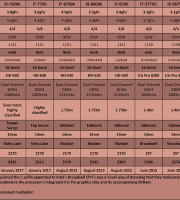
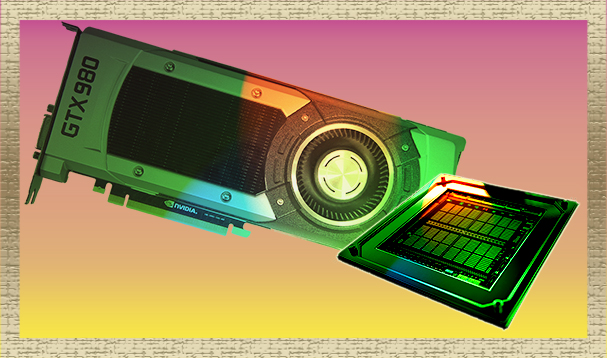
Golden Era’s of anything that sounds nice, travels fast, jumps high, hits hard or permits great luxury for less graft are defined by a intricate mixture of objectivity and subjectivity.Facts are substantiated by evidence and statistics, opinions empowered by emotion and belief, but from the moment one rejoices in relativism, nothing can thrive on proof of any sort. Nevertheless, if 2014 defined a golden year for heavyweight desktop delights, to dispute the relentless pressure it faced from from an advancing front of super evolutionary tablets, phablets, mobiles and laptops would amount to claiming that this was a really terrible motor car.
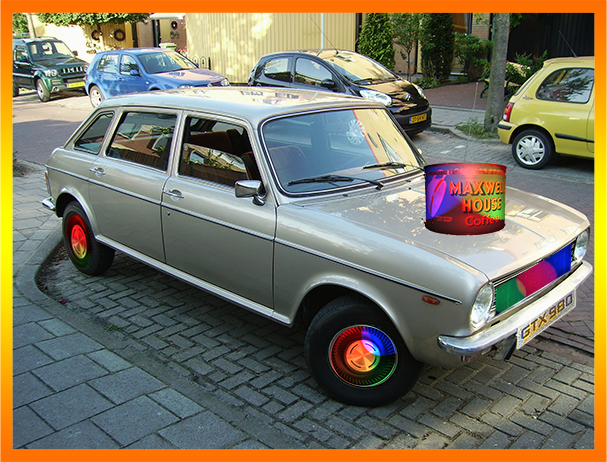
Yet whenever the capitulation of old school computing seemed immanent and certain enough for a Nostradamus apologist to take to Ladbrokes, our generals in the wilderness, themselves with a vested interest in the slimming market, steadfastly refused to forsake their past.
Onwards they would stride, ravenous rivals deprived of autonomy by each others mere existence. One adorned in charming cherry crimson, the next in garish grape green and the last in beguiling berry blue. All three grudgingly but gallantly bearing the brutal weight of the mammoth mahogany, ash, oak, or cedar surfaces that symbolized their dominance of decades gone by until, from their combined efforts, frustration and fatigue, a fresh craving to conquer ignited one great mind.
As Septembers redemptive autumnal musings meandered to a close. It was old Giant Green Eyes who was to answer the audiences deafening demands, making it impossible for the stage manager to dim the lights and courteously urge a packed house that times had changed. It was he who would take on the Mantle with an encore of “Maxwell” magnificence….figuratively and absolutely and right from where the flag of his fiery bearded foe now flew.
The tapestry chronicling this treacherous trading of Teraflops was last abandoned with its threads delicately poised.
AMD’s “Hawaii” had yielded emphatic performance returns through a combination of innovative power management, increased memory, a bountiful bus, more cores, compute and texture units, two times the ROPs and the burning of bridges. What’s that? I missed the transistors? Look, there they wallow, in that fact laden table, oozing with chocolatey figures, gorge my friends.
Moreover, it had duly addressed weaknesses unearthed by a growing trend of stringent testing techniques, the most injurious being a frame rate, interval and rendering anomaly exhibited by its flagship cards, the 7970 when running in Crossfire and later, their twin Tahiti toting 7990. The tests were pioneered by two groups of accomplished PC practitioners working for equally accredited websites – the debate as to which was first rages on – and were a successful attempt to expose the mysteries of micro-stutter.
Their procedure involved recording the native output of the video card on trial using a powerful purpose built capture system, which identified a resolution of up to 2560×1600 and ingested footage at 60 frames per second. A RAID array of super-charged SSDs ensured every frame was preserved in an uncompressed avi file, where it could be subsequently extracted for further analysis.
Prior to this, FRAPS, a software based screen grabber, was the principal method for garnering the data in question, though by intercepting the frame buffer, its measurements were based exclusively on the video card’s raw output and failed to highlight imperfections observed by the player once the images had been passed to their display.
In recording exactly what the gamer saw, then reviewing statistics that divulged not just the frame rate, but detected any incomplete or “dropped” frames, logged the exact time each frame expended on the screen and conveyed accurate percentages of fast, slow and average display times, a new, unimpeachable package of results could be collated and offset against those generated by FRAPS in the same tests. The experiment revealed that a tag team of “Tahitis” was persistently wayward when compared to co-habiting Keplers. Frame rates and display durations would fluctuate, clusters of frames were either compromised or omitted entirely and a larger proportion occupied the screen for longer. Aside from enforcing a tarnished visual experience, when collectively accounted for in benchmarks previously monitored by FRAPS, these ailments effectively hampered the prowess of AMD’s multi and dual GPU solutions by between 20 and 50%
Without wishing to delve into the deluxe coffee table edition of “Who’s GPU” for the umpteenth time, for we are in the past tense already, it was two years earlier that this problem, then attributed to the red team’s “Cayman” chip, initiated a succession of embarrassing own goals and its cure was more crucial to their recovery than any other benefit subsequently observed.
On the day AMD’s Hungry Hawaiians first paraded their assets, Nvidia’s battle plan seemed watertight. The GK110 was a GPU with greater reserves than Fort Knox and had already enchanted the richest enthusiasts in its exorbitant “Titan”form. Thus, Green Eyes nonchalant response to his Nemesis was to halve the memory, dial up the core speed, ditch double precision, and -release two cheaper variants, the GTX 780 and 780 Ti, both vehemently targeting the cutting edge gamer and priced appropriately.
Then erupted mount Vesuvius. Under normal circumstances, a launch price topping $1000 might have appeared prohibitive, but in delivering such a devastating array of results, the R9-295x pre-empted comical complacency in the guise of Nvidia’s official counter, the dual Kepler Titan-Z , which yielded inferior frame quotas for double the dollars and arguably forced camp verdant to hastily re-market their colossal creation as a product for privileged medical students with an occasional penchant for Portal.
On forums, things like this were happening.
Fanboy No.1. The R9 290X trashes your 780 Ti. It’s better value, has an extra gig of RAM and is faster at 4K, especially in crossfire, plus you can get two for the price of one Titan Black.
Fanboy No.2. The Titan Black was never intended to compete with the R9s. Nvidia’s new drivers drastically improve the 780 Ti. It’s just as good at 4K. All those reviews have the R9 290 in “Uber mode” which cranks up the fan and boosts the core speed automatically, its basically a head start. The 780 Ti over-clocks like a champ, runs much cooler and consumes way less power, about 50w per card under load. If you clocked and cooled it in line with a 290x, it would destroy it, single v single or SLI v crossfire, would’t matter.
Fanboy No.1 But it’s 100 dollars dearer and no quicker overall, if the noise bothers you just get card with a non-reference cooler or water cool a stock one with the cash you’ve saved, then you could ramp up the core and memory even further.
Fanboy No.1 Please, then you’d have a card that draws around 350W and tops 95C the entire time, and think of two in crossfire! How about this, buy a non-standard 780Ti or or water-cool a stock one, spend a bit more up front but have a card that is quieter, cooler, faster by default, has more clocking headroom and recoup the extra investment by saving those watts.
Fanboy No.3. The Titan-Z is the best card on the planet, it doesn’t need native water cooling, won’t cause lifts in your block to stall, has more memory, ultimate double precision power and can be over-clocked far higher than the R9 295×2.
Fanboy No.4. C’mon, its twice the price, when it’s over-clocked it’s still slower and sucks just as many watts. Who cares about the water cooling?Spend the money you’ve saved on a bigger case. No gamer needs or wants double precision and 12 gigs of ram? What game is gonna max that out? 8 gigs is plenty.
Fanboy no.3. But It’s watercooled out of the box, that’s cheating, if you put a Titan-Z under water it would best a 295 across the board.
Fanboy No.4. Errr. Yeah, you’ve just spent $2500 on a graphics card that’s slower than one you can buy for over $1000 less and what’s your first bright idea…spend another $100 on cooling it. Your call pal.
And so, with both Green Eyes and Red Beard still furiously flogging what wise bards of technology were declaring a deceased manufacturing process, it was time for another quantum leap, not only in speed, but eco-elegance and there was where Maestro Maxwell’s symphony sung its sweetest.
Meet the The GM204
Right, that’s enough of the silly similes, time I need a table treat to attend to our sanity.
To any and all with an acute aversion to tables, let’s get the stats out of the way, for if there’s one thing our fresh roasted duo of débutantes proves, its that no isolated figure has any meaningful bearing on synthetic or organic performance, at low or high resolution, and with or without and eyeful of sugar and spice. Indeed, it was these very characters that search for such that elusive magic number would yield not a hint of wisdom.
Note the figures for texture units, render output processors and stream/shader processors. The first directly dictates texture fill rates, the while the third primarily governs floating point proficiency. But when seeking a silky, satisfying, responsive and engaging session of Battlefield brutality, which matters the most? Is it any of them?
Regard our new arrivals, the 980 and the 970…fancy that…less texture units than the Titan Black, R9 290X and 780Ti, fewer stream processors than all three and hence, lower texture fill rates and floating point proficiency. What about the memory bus? The girth of which almost every shrewd statistician declares a pivotal factor in bids for eye candy ecstasies? Look again, the 980 and 970, 256bits? A third slimmer than the Titan Black and 780Ti, half that of the R9 290x and only equalling the two year old GTX 680.
Let’s try again, memory bandwidth? Wasn’t that once all the range? Greater bandwidth, lesser stutter? Examine our inductees once more, just 224GB/s, lower than their three former flagships. Transistors? Yet another undercut, by 1 and 1.8 billion relative to the Hawaii and GK110. And die size? Indeed, you didn’t misread, just 398mm, almost 10% leaner than the islander and 30% easier on the wafer than a Kepler thoroughbred. The RAM itself?, 4GB, more than its spiritual elder, level with the Ruby Devil but below the Titan Black.
Most remarkable of all was the power savings and speed bonuses afforded by these extensive cuts. Base and boost core frequencies of 1050 and 1126mhz for the GTX 970 and of 1178 and 1126,mhz for the 980 and what about those extraordinary TDPs? 148 and 165 watts and all from a GPU whose conception was supposedly hampered by an ageing production process, definitive proof of the Moore’s law limit?
Nobody would deny a GPU’s frequency serves as a catalyst for performance, nor memory to be an influential resource. But a forum dwelling stat junkie desperate for evidence will often attribute all appreciable improvements to whichever figures have risen the most, and this time around, it was the ROPs (render output processors) that reaped their plaudits. Hoorah for the ROPs, for they hold the key to the 4K kingdom. 64 redoubtable nano-nibelungs responsible for preparing and presenting pixels to perpetually starving screen addicts.
The ratio of ROPs to Memory controllers was cited as being of critical importance, which means you are compelled to inspect the following slides . God I hate this bit.
Though it induced a larger ripple, the GM204 was not the first “Maxwell” to enter uncharted cases. A distant and diminished cousin, the GM107, endowed with eco-talents every bit as impressive, had proudly piloted the 750 Ti into the budget market almost six months earlier and the revised layout of this chip’s central components was vividly manifest in its majestic counterparts.
When sitting atop of the GTX 980, the GM204 fired on sixteen SMMs. SMXs had become SMMs, I knew what SMX stood far (streaming multi processor”extreme”) but this mysterious new “M”, sorry no idea and Google wouldn’t inform me so I proceeded unabated. These were divided into four GPCs (Graphics Processing Clusters).
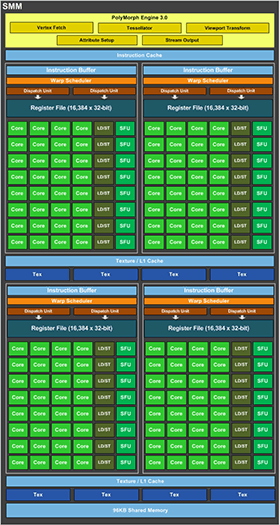 A single SMM hosted, loved and cherished a congregation of 128 streaming processors and 8 texture units. In place of the sole cathedral that housed this Cuda Core Choir when under the Kepler’s command, four discreet churches were now appointed, each with its own instructor. An alteration that Nvidia claimed coaxed the cores to sing 40% sweeter and louder than before.
A single SMM hosted, loved and cherished a congregation of 128 streaming processors and 8 texture units. In place of the sole cathedral that housed this Cuda Core Choir when under the Kepler’s command, four discreet churches were now appointed, each with its own instructor. An alteration that Nvidia claimed coaxed the cores to sing 40% sweeter and louder than before.
8 texture units served each SMM and the blue dashes above and below 2 megs of level 2 cache, those were the ROPS, 64 in total and 16 allocated to each memory controller, there where it says memory controller on the left and rights sides. And cease.
The true secrets to a “Steamer’s” smooth and speedy salvation lie in the sickeningly scientific architectural refinements that only the most accomplished hardware hagiographers could aspire to coherently convey. As one is not this article’s author, let’s survey the obvious upgrades.
Over the preceding months, several distinct, state of the art and heavily marketed gaming technologies catered for gourmets with varying tastes.
There were those that veered toward Clan 4K, whose pallets savoured their pixels in a single gargantuan portion and the others, paid up or potential members of the GSync guild, who preferred to sacrifice surgical detail for roaring refresh rates or experience a three course cocktail of colour and texture. Sooner or later, these factions would join in a triple screen, 4K, GSync wonderland with 120hz available to all.
In the mean time, Nvidia’s attempt to address what was becoming a painful dilemma for both groups of enthusiasts, came in the form of “Dynamic Super Resolution”, a process whereby all glorious graphical content is rendered at 4K and beyond, then down-sampled in accordance with the host monitor’s native resolution.
The system was enabled at driver level via Nvidia’s “Geforce Experience” software, though at the time of release, how it differed from more traditional forms of anti-aliasing, or similar options accessible from within games themselves, remained ambiguous.
Moving onto the physical changes, where before there were DVI brothers in arms, only one now remained, its doppleganger dispatched in favour of a display port. Two further display ports sat alongside, all three revision 1.2 and lastly, one HDMI socket in its second incarnation, supporting 4K at 60hz and making triple quad HD fesible on a single card.
Also worthy of mention, was the Maxwell’s extensive video harvesting and playback features. A heavily upgraded encoding engine (NVENC) meant user’s could now benefit from dedicated H.265 encoding, a function never previously observed on any PC GPU.
In addition, and of enormous significance to gaming archivists seeking premium quality, Nvidia’s maiden “Maxwell” driver package introduced profiles of 1440p and 2160p (4K) to its Shadow Play recorder, each capable of logging a “Let’s play” at 60 silky frames and 130 megabits per second!
To complement, there was MFAA Multi Frame Sampled Anti-Aliasing, yet another novel technique for touching up edges and supposedly 30% swifter than traditional MSAA, with a negligible loss in quality
Full implementation of Direct 3D 12 and an enigma referred to as “Voxel accelerated global illumination”, rounded off our Emerald Giant’s ingenious concoction. Don’t ask me to explain either in detail…because I can’t.
In 2012, a range topping video card that required no more than 195W to provide its finest service emerged, its name was the GTX 680 and the GK104 that commanded its helm was hailed as a breakthrough in the infinite paradox of performance and efficiency. Two years later, 165 watts was all that was needed for its descendant to deliver twice the delights.
Suffice to state the “Maxwell” was a solution that required less of almost every key ingredient, whilst indulging the customer with more acute flavours and a pleasant feeling of fullness. Surely a firm indication that Green Eyes and his goblins were prioritizing the development of portable, energy sparing solutions before meticulously remoulding resultant designs and components into products for those who defied a desk-less existence.